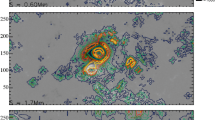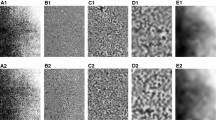Abstract
Solar flare films obtained on the TRACE spacecraft with a resolution of 1″ in the 160-nm (CIV) band with a frame separation of 2 s are examined. It has been indicated that the flare scenario is determined by the dynamics of numerous structures of about 1000 km in diameter. The fractal nature of the flare is confirmed. A self-organized criticality (SOC) mechanism is proposed to explain the flare formation and development. The most probable source of the flare energy is considered to be the chain of three-dimensional solitons.
Similar content being viewed by others
References
M. J. Ashwanden, “Particle Acceleration and Kinetics of Solar Flares,” Space Sci. Rev. 100(1/2), 1–227 (2002).
P. Charbonneau, S. W. Mc Intosh, Han-Livin, and T. I. Bogdan, “Avalanche Models for Solar Flares,” Sol. Phys. 203, 321–353 (2001).
J. Feder, Fractals (Plenum Press, New York, 1988; Mir, Moscow, 1991).
L. A. Fletcher and H. P. Warren, “The Energy Realize Process in Solar Flares Constrained from TRACE Observations,” Lect. Not. Phys. 612, 58–71 (2003).
L. K. Lawrence, “Diffusion of Magnetic Flux Elements in Fractal Geometry,” Sol. Phys. 135, 249–259 (1991).
L. K. Lawrence, A. C. Cadasin, and A. A. Rusmakin, “Turbulent and Chaotic Dynamic Modeling Solar Magnetic Variability,” Astrophys. J. 455, 366–375 (1995).
L. Lamb, Jr. and D. W. Mc Laughlin, “Solar Physics Aspects,” in Solitons, Ed. by R. K. Bullough and P. J. Caudrey (Springer, Berlin, 1976; Mir, Moscow, 1983).
A. B. Mandelbrot, “The Fractal Geometry,” Science 135, 63 (1967).
A. B. Mandelbrot, The Fractal Geometry of Nature (San Francisco, 1982).
E. I. Mogilevsky, Fractals on the Sun (Fizmatlit, Moscow, 2001) [in Russian].
A. A. Samarsky, V. A. Galaktionov, S. P. Kurdyumov, and A. P. Mikhailov, Intensification Modes in the Problems for Quasilinear Parabolic Equations (Nauka, Moscow, 1987) [in Russian].
M. Socas-Navaro and B. W. Lites, “Observation Evidence for Small-Scale Mixture of Weak and Strong Fields in the Quiet Sun,” Astrophys. J. 616, 587–593 (2004).
A. V. Vlasov, Non-local Statistical Mechanics (Nauka, Moscow, 1978) [in Russian].
A. V. Vlasov, Statistical Distribution Functions (GIZ, Moscow, 1936) [in Russian].
L. M. Zelenyi and A. V. Milovanov, “A Dynamical Model of Fluctuations in the Interplanetary Magnetic Field: Fractal Excitation and Power-Law Spectra,” Geomagn. Aeron. 37, 1–13 (1997) [Geomagn. Aeron. 37, 1–8 (1997)].
L. M. Zelenyi and A. V. Milovanov, “Fractal Topology and Strange Kinetics: from a Percolation Theory to the Problem of Space Electrodynamics,” Usp. Fiz. Nauk 174, 809–852 (2004).
Author information
Authors and Affiliations
Additional information
Original Russian Text © E.I. Mogilevsky, N.S. Shilova, 2006, published in Geomagnetizm i Aeronomiya, 2006, Vol. 46, No. 3, pp. 320–325.
Rights and permissions
About this article
Cite this article
Mogilevsky, E.I., Shilova, N.S. Fractal-cluster analysis and small-scale structures of solar flares. Geomagn. Aeron. 46, 303–308 (2006). https://doi.org/10.1134/S0016793206030030
Received:
Accepted:
Issue Date:
DOI: https://doi.org/10.1134/S0016793206030030




